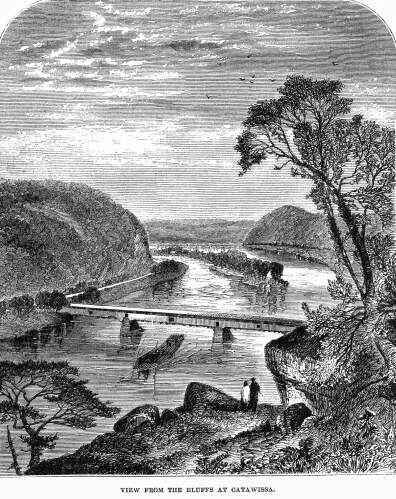
THE CATAWISSA RAILROAD
Harper's Monthly—1862
PENNSYLVANIA has long been celebrated for the magnificence
of the scenery afforded by the Alleghenies and the Blue Ridge,
and by the valleys, of the Susquehanna, Allegheny, Monongahela,
Delaware, and Schuylkill rivers. Since the completion of the various
lines of railway throughout the State, the facilities for visiting
these mountains, valleys, and rivers have become entirely within
the reach of all, especially the residents of the populous cities
of our sea-board.
The Catawissa Railroad, with the roads directly connected with
it, for one hundred and nineteen miles passes through the valleys
and over the mountains of the Blue Ridge; commencing at Port Clinton,
on the line of the Philadelphia and Reading Railroad, and terminating
at Williamsport, the county seat of Lycoming County. The lower
portion of the road is that of the Little Schuylkill Railroad
Coal and Navigation Company, which is principally engaged in the
transportation of coal from the Tamaqua District, being an important
feeder to the Philadelphia and Reading Railroad. The northern
portion has largely aided in the development of the immense lumber
traffic of the west branch of the Susquehanna River; Williamsport
being surrounded by extensive steam saw-mills, cutting many millions
of feet annually of most excellent timber, flooring, scantling,
laths, and pickets from the rafts of logs floated down from the
forests in the northwest section of the State.
 The central
portion of the Catawissa Road is that which affords the most characteristic
scenery. The view of the Schuylkill River at Port Clinton will
give the traveler, as he alights from the cars of the Philadelphia
and Reading Railroad, a foretaste of the rich treat in store for
him. The river, gracefully winding southwardly from the town,
is lost to sight behind the mountain through which the railroad
tunnel has been cut. Its waters, of a bright-green color, completely
landlocked, and calm as a lake, are only rippled by the slowly-lagging
canal-boat laden with coal, which at intervals is dispatched from
the coal "shutes" just on the other side, or coming
from farther up stream, is bearing its freight of black diamonds
to Philadelphia or New York and a market. Looking up stream, a
very substantial bridge spans the river over which the Little
Schuylkill Railroad crosses; and the route now for twenty miles
follows the river of that name in its tortuous windings. The central
portion of the Catawissa Road is that which affords the most characteristic
scenery. The view of the Schuylkill River at Port Clinton will
give the traveler, as he alights from the cars of the Philadelphia
and Reading Railroad, a foretaste of the rich treat in store for
him. The river, gracefully winding southwardly from the town,
is lost to sight behind the mountain through which the railroad
tunnel has been cut. Its waters, of a bright-green color, completely
landlocked, and calm as a lake, are only rippled by the slowly-lagging
canal-boat laden with coal, which at intervals is dispatched from
the coal "shutes" just on the other side, or coming
from farther up stream, is bearing its freight of black diamonds
to Philadelphia or New York and a market. Looking up stream, a
very substantial bridge spans the river over which the Little
Schuylkill Railroad crosses; and the route now for twenty miles
follows the river of that name in its tortuous windings.
The banks of this river are fringed with the rank undergrowth
peculiar to mountain streams. The tall pine-trees rear their stately
forms upon either side, and here and there a bit of cleared land
indicates the presence of thrift and industry, the out-buildings
and tenement-houses giving evidence of the pursuit of a home under
difficulties. At the town of Ringgold, just ten miles on the journey,
the tank of the engine is replenished with wood and water. There
is nothing special to note other than the reminiscence of the
Mexican war and the brave commander of the battery which bore
his name, afforded by the mention of this station.
Approaching the thriving borough of Tamaqua the traveler obtains,
in many instances, his first correct impressions with reference
to the anthracite coal region of Pennsylvania. Vast piles of the
refuse coal and dirt from the mines, covering miles in extent,
are seen upon either hand. They are a source of immense loss to
the operator or miner. The valley at and in the immediate vicinity
of Tamaqua being so narrow, and the surface of the level land
being consequently so circumscribed, it has been necessary to
follow down the stream for miles to find a place to dump the large
quantities of dirt from the mines. These piles of refuse would
appear, to the casual observer, to be of great value, the presence
of coal in greater or less quantities being unmistakable. And
so they would be fortunes for hundreds of people if in New, York
or Philadelphia; but the cost of transportation thitherward would
far more than absorb the value of the portion of coal which they
contain.
In passing these huge dirt heaps, the question of profit and
loss, to the mind accustomed to such problems, most naturally
comes up; and the hardships, the toils, and the losses of the
miner are most vividly portrayed, when it is considered that it
has cost him full as much to produce each ton of this refuse which
is thrown aside as utterly valueless, as it has done to produce
the ton of coal ready for market, and for which be is so sparingly
paid.
About a mile below the town the opening or mouth of a mine,
with its out-buildings, machinery, side-tracks, horses, mules,
and drivers, furnishes a fair specimen of over one hundred and
fifty just such extensive operations as are daily going on within
a circuit of fifty miles from Tamaqua.
 Fifteen miles to the eastward
the Lehigh Coal and Navigation Company have their extended and
varied coal-fields, the thriving borough of Mauch Chunk being
its mercantile and shipping point. About the same distance northwardly
the Hazelton Coal Company, with other operations of newer organization,
produce large quantities of coal; while to the eastward, within
a range of twenty-five miles, the Pottsville, Minersville, and
Ashland districts are dotted with openings, giving forth annually
several hundreds of thousands of tons of anthracite. Fifteen miles to the eastward
the Lehigh Coal and Navigation Company have their extended and
varied coal-fields, the thriving borough of Mauch Chunk being
its mercantile and shipping point. About the same distance northwardly
the Hazelton Coal Company, with other operations of newer organization,
produce large quantities of coal; while to the eastward, within
a range of twenty-five miles, the Pottsville, Minersville, and
Ashland districts are dotted with openings, giving forth annually
several hundreds of thousands of tons of anthracite.
The immediate surroundings of the opening of a coal-mine in
full operation present a busy scene. The constant puffing of the
pit engine, as it toils and labors in hoisting the coal-buckets
from the bottom of the mine, or as it draws up upon the inclined
plane the small mine cars loaded with the miner's products, reminds
the traveler who has been on the Western waters of the lullaby
those high-pressure steamboats afford in their hoarse cough, which
never forsakes him while on board.
The large frame building, which inclines from a considerable
elevation toward the tracks, covers the system of screens and
"shutes" which clean and separate the different sizes
of coals for steam, heating, and household purposes, after the
larger lamps have been passed through the rollers or "breakers,"
as they are called, contained in the tower-like structure which
surmounts all.
The breakers are rapidly driven by a separate engine from the
pit machinery, and the crushing of the coals with the revolving
of the large iron screw below, the running of the coals from shutes
to the cars, the yelling of drivers as they urge their mules at
their work, all combine to make a hideous noise entirely peculiar
and never to be forgotten.
The town of Tamaqua is a very thrifty, interesting place, contains
a number of churches, school-houses, banks, etc., and its interests,
its hopes and fears alike, are dependent upon the coal-trade.
The machine shops of the Little Schuylkill Railroad Company are
here located; and in these identical shops there stands to-day,
exempt from duty, the original engine imported by the Company
nearly thirty years ago—one of the first, if not the very
first, locomotive engines brought out from England to this country;
and there still lives, in the borough of Tamaqua, the identical
machinist who came out along with the wonderful machine to put
it together and ran it. The Little Schuylkill Railroad was the
pioneer railroad in Pennsylvania, and the boiler of this locomotive
was hauled upon a wagon drawn by horses the entire distance, eighty
miles, from Philadelphia to Port Clinton, by turnpike; and all
this within the memory of man. When we reflect that, to-day, more
than four thousand locomotives of American manufacture are in
daily use in the United States alone, and over twenty-eight thousand
miles of railway are constantly traversed by them, it is surely
a matter in itself of great interest to behold the imported engine
of thirty years ago, and the man who came along with this great
reformer to put it together for use.
The various coal-mines in the vicinity of Tamaqua will well
repay the traveler to sojourn among and carefully visit them.
The superintendents of these subterranean scenes of life are generally
courteous, and happy to afford every opportunity to those in search
of knowledge or pleasure to gratify their desires. True, it requires
some nerve, more faith, and a total disregard to a temporary soiling
of the hands, face, and clothes. Besides these prerequisites,
the seeker for knowledge should have a guide in the person of
the superintendent, or some one who is perfectly familiar with
the special premises about to be visited.
 Powder in large quantities, of
coarse grain, is used in mining coal; and were it not for the
perfect system of ventilation connected with every well-regulated
mine, the air inside would be entirely insufferable from the impregnation
of sulphur fumes arising from the frequent blasts. This ventilation
also serves to carry off "the fire-damp" which collects
in the mines. It also serves to free the galleries and tunnels
of the carbonic acid and other deadly gases. The visitor to the
inside of a coal-mine will be struck with the free circulation
of pure air away below the surface of the earth. Powder in large quantities, of
coarse grain, is used in mining coal; and were it not for the
perfect system of ventilation connected with every well-regulated
mine, the air inside would be entirely insufferable from the impregnation
of sulphur fumes arising from the frequent blasts. This ventilation
also serves to carry off "the fire-damp" which collects
in the mines. It also serves to free the galleries and tunnels
of the carbonic acid and other deadly gases. The visitor to the
inside of a coal-mine will be struck with the free circulation
of pure air away below the surface of the earth.
In the vicinity of Tamaqua there is a burning mine, which many
years ago caught fire in one of the galleries from a fire ignited
by some of the workmen to warm themselves by. Through some means
or other the fire was left to burn in contact with the coal, which
was of a highly combustible character, and communicating with
large quantities of coal contiguous to it, the fire became of
such magnitude as to be beyond the power or control of man, and
no human agency has since been devised to quench it. The exact
extent of its bounds is unknown; but like a volcano, it is a dreaded
locality, and conjecture alone can approach the amount of the
immense loss occasioned by this singular and uncommon accident.
The direction from Tamaqua of the "Burning Mine" is
known to every urchin of the place; and the traveler will have
the opportunity to visit—at a safe distance—the mouth
of the pit.
Leaving Tamaqua, the Little Schuylkill Railroad soon terminates
and the Catawissa Railway commences. The transition from one road
to the other is, however, unknown to the occupant of the cars,
the gauge of track being precisely the same, and the roads for
all traveling and freight intents and purposes one and the same.
The grade of the road now becomes steeper than at any portion
of it heretofore traversed; and the traveler is reminded, by the
rapid falls of water of the mountain stream, now narrowing on
the right as be proceeds, that the mountain is being climbed by
the engine and train.
Nearly ten miles of heavy grade, full sixty feet to the mile,
of such journeying and the Quaquake Valley is spread out far down
the mountain side. Extending for many miles far away to the eastward,
the valley is inclosed by range upon range of mountains, until
all is lost in the haze of extreme distance.
As the railway winds around the mountainside the junction of
the Quaquake Valley Road is soon reached, where the connection
of a line of railway to New York City, hereafter referred to,
is made. After passing the short tunnel a few miles further on,
the road enters one of those gloomy pine forests so peculiarly
American. Huge masses of conglomerate rock crown the summit of
the mountain, ponderous boulders lie scattered at the base, bespattered
with the black and gray lichen; while the pines, dark, tall, and
sinewy, seem to keep a grim watch over all. A feeling of awe steals
over the mind 'while passing through this forest, giving all the
more zest for the brightness and beauty which so soon follows.
The summit of the mountain is reached, and here the Little
Schuylkill River has its birth. A bit of rude masonry on the west
side of the road marks the spot where the young waters come gurgling
forth from their dark confinement, and joyously go babbling on
their way over snow-white pebbles, and under banks of moss and
fern, to swell the great tide of the Delaware. This spot is one
of peculiar interest to the tourist: the whole scene is particularly
romantic. The spring, surrounded by dark hazel bushes, with here
and there a stately pine-tree to relieve the back-ground, makes
up a choice picture; while off to the eastward a rocky spur of
the mountain, with the entrance to the tunnel in its blackness
clearly defined, adds to the wildness of the locality.
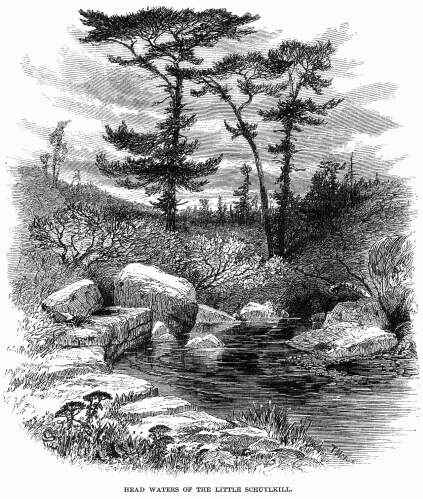 Passing through this tunnel at
the summit, the first view of the beautiful Valley of the Catawissa
Creek is obtained—Catawissa, an Indian word, signifying "pure
water." The creek has its rise in the tunnel in the form
of a freely flowing spring, and is followed by the railroad, through
its whole length, to its confluence with the Susquehanna. This
occurs at the town of Catawissa, some thirty miles distant. From
this point the views from the road present a series of grand panoramic
pictures of the highest type of mountain scenery. Looking backward
from the curve at Sweet Spring Hollow (a few miles further on)
a doable valley is seen, formed by a secondary range of hills
intersecting the valley from Summit Tunnel to this point. The
mountains here attain their greatest altitude; and their ever-varying
forms, with occasional glimpses of the sparkling Catawissa, caught
through the light and graceful foliage of the mountain birch,
form a series of charming pictures. Passing through this tunnel at
the summit, the first view of the beautiful Valley of the Catawissa
Creek is obtained—Catawissa, an Indian word, signifying "pure
water." The creek has its rise in the tunnel in the form
of a freely flowing spring, and is followed by the railroad, through
its whole length, to its confluence with the Susquehanna. This
occurs at the town of Catawissa, some thirty miles distant. From
this point the views from the road present a series of grand panoramic
pictures of the highest type of mountain scenery. Looking backward
from the curve at Sweet Spring Hollow (a few miles further on)
a doable valley is seen, formed by a secondary range of hills
intersecting the valley from Summit Tunnel to this point. The
mountains here attain their greatest altitude; and their ever-varying
forms, with occasional glimpses of the sparkling Catawissa, caught
through the light and graceful foliage of the mountain birch,
form a series of charming pictures.
After passing Beaver Station, some three or four miles distant,
there is presented a most striking and characteristic view from
Stranger's Hollow. This is of a deep mountain gorge through which
the Catawissa is seen hurriedly making its way over its rocky
bed. The whole scene is particularly wild, and the surroundings
give less evidence of the footprints of man than perhaps any other
portion of the road.
Further on, at Maineville, there is a gap in the mountain chain,
which, although not so grand as the Delaware or Lehigh Gaps, presents
a very beautiful view. Approaching the mountain upon the west
side of the Gap, the railroad track crosses a narrow ravine upon
a substantial bridge supported by stone piers, immediately beneath
which, to the eastward, is located the town of Maineville. Looking
through the Gap, a most beautiful highly cultivated valley brightens
up the picture, which, at a distance of a mile or more, as the
train approaches the bridge, seems to be framed, by the mountains
on either side. The view from the bridge, looking toward the Nescopeck
and M'Cauley Mountains in the distance, is also very lovely.
The village of Maineville, is a quaint, quiet, finished town
that seems to have always been as it now is, and as if determined
to remain so, looking up at each passing train with a wonder that
never seems to grow less. Equally astonished seems the hitherto
boisterous Catawissa, here for the first time checked in its freedom
by the milldam. It seems silly to bear the impost it is now for
the first time compelled to pay to the buckets of an uncovered,
undershot mill-wheel belonging to the miller of Maineville.
 Seven miles further on the ancient
town of Catawissa is located—upon the banks of the beautiful
Susquehanna, at its confluence with the Catawissa Creek. Several
churches, an excellent hotel, and a most hospitable resident population
are the attractions of Catawissa proper; while it is the centre
of some of the most sublime views along the whole line of this
road. The mountain views and scenery, heretofore relieved by the
waters of the Catawissa Creek, are now accompanied by the gracefully
winding waters of the Susquehanna. Seven miles further on the ancient
town of Catawissa is located—upon the banks of the beautiful
Susquehanna, at its confluence with the Catawissa Creek. Several
churches, an excellent hotel, and a most hospitable resident population
are the attractions of Catawissa proper; while it is the centre
of some of the most sublime views along the whole line of this
road. The mountain views and scenery, heretofore relieved by the
waters of the Catawissa Creek, are now accompanied by the gracefully
winding waters of the Susquehanna.
The view looking up the river from the bluffs a short distance
below the town, has been pronounced inferior to none, in point
of beauty, in this country. At an elevation of two hundred feet
perpendicular, which is readily attained by an easy ascending
path just back of the town, a most beautiful panoramic view of
the North Branch of the Susquehanna, with the island, bridges,
canal, railroad, etc., is obtained. The island seen from the bluff
is named the Catawissa Island, a most delightfully-shaded retreat
from the summer sun, while the cool breezes constantly wafted
from the river contribute to make it most desirable to visit.
The canal seen to the westward, winding its way around the base
of the mountain, is the "North Branch Canal," formerly
the property of the State of Pennsylvania, but recently disposed
of to private individuals, in accordance with an act of Legislature
providing for the sale of all public improvements, canals, and
railroads. Looking up to the bend of the river, the Catawissa
Railroad Bridge is in view; and nearer, below the island, the
County Bridge, one of the old-timed, covered wooden structures,
with stone piers, crosses the river in front of the town.
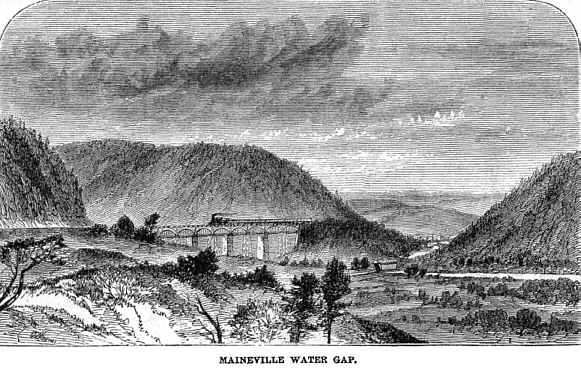 Many years gone by the red men
of the forest used to come to this point of the river, below and
about the island, as a favorite fishing-ground. Salmon, large
and plenty, abounded here; and even forty years ago it was no
uncommon occurrence to catch salmon in their seine while fishing
for shad at this very point. The Susquehanna has long since, however,
been without the excellent fish which once abounded in her waters.
The building of dams, canals, etc., frightened off the fish, so
that they ceased frequenting the former streams and localities,
and are now, particularly the salmon, entirely foreign to the
waters of the State of Pennsylvania. Many years gone by the red men
of the forest used to come to this point of the river, below and
about the island, as a favorite fishing-ground. Salmon, large
and plenty, abounded here; and even forty years ago it was no
uncommon occurrence to catch salmon in their seine while fishing
for shad at this very point. The Susquehanna has long since, however,
been without the excellent fish which once abounded in her waters.
The building of dams, canals, etc., frightened off the fish, so
that they ceased frequenting the former streams and localities,
and are now, particularly the salmon, entirely foreign to the
waters of the State of Pennsylvania.
Back of the town of Catawissa, from the top of the mountain
looking due east, we have a most magnificent view of the Catawissa
Valley, with the meandering course of the creek before us for
fifteen miles, winding in the dim distance like a silver thread.
This is another characteristic scene, and one that has attracted
the attention of artists; work of great merit, taken from this
identical landscape, having been produced by the artist Moran,
of Philadelphia, which attracted considerable attention and elicited
the highest encomiums from connoisseurs at the recent artists'
reception of Philadelphians. The time chosen in his picture is
the fall of the year—the forests tinged with gold and crimson—the
first coloring of leaves by early frost, most beautifully delineated,
greatly heightening the effect of the picture. The railroad, in
sight all the way up the valley, furnishes, at times, the only
lifelike object, when the train of cars with its engine, and white,
puffing steam ascending, gives something moving to relieve the
dull quiet, under certain conditions of the atmosphere, inseparably
connected with so extended a view.
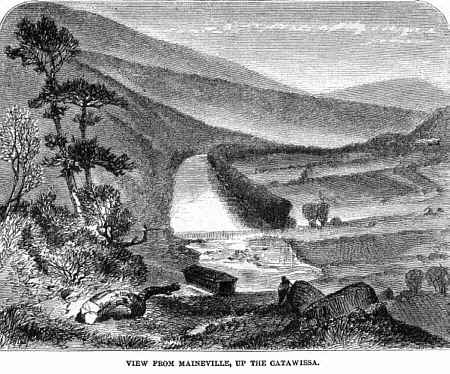 Ascending the mountain-slope
to the north of Catawissa, a very striking view of the town and
surroundings is obtained, not to be secured from the other eminences.
The town is located on a flat piece of land between the mountains,
extending down to the banks of the Susquehanna. Looking downward,
the County Bridge, below the island, stretches across the stream;
the railroad, winding southwardly from the bridge just beyond,
enters the town at the foot of the mountain. Looking upward, or
northwardly, the bridge of the railroad is very near to us, while
beyond, the very pleasant town of Bloomsburg is in sight. Farther
on are gracefully-sloping hills, dotted with farms, while the
great North Mountain, dim from distance, closes the scene. Ascending the mountain-slope
to the north of Catawissa, a very striking view of the town and
surroundings is obtained, not to be secured from the other eminences.
The town is located on a flat piece of land between the mountains,
extending down to the banks of the Susquehanna. Looking downward,
the County Bridge, below the island, stretches across the stream;
the railroad, winding southwardly from the bridge just beyond,
enters the town at the foot of the mountain. Looking upward, or
northwardly, the bridge of the railroad is very near to us, while
beyond, the very pleasant town of Bloomsburg is in sight. Farther
on are gracefully-sloping hills, dotted with farms, while the
great North Mountain, dim from distance, closes the scene.
Leaving Catawissa, distant three miles the town of Rupert is
located, at the junction of the Catawissa and the Lackawanna and
Bloomsburg railroads. This latter railroad takes the tourist to
the historical and romantic valley of Wyoming.
Seven miles beyond Rupert the town of Danville is reached.
Danville is the site of the extensive iron-works of the Montour
Iron Company, which has for many years past been heavily engaged
in the manufacture of railway iron. A large number of men are
constantly employed by this Company; and the close proximity to
furnaces of heavy capacity enables the mills to produce very large
quantities of rails. Of late years the practice has obtained more
than ever among the managers of the railway companies throughout
the United States of re-rolling the rails heretofore disposed
of as old rails, and credited at a sometimes nominal rate; whereas,
under the existing state of things, the rails are reproduced and
made to last many years. The Montour Company is, next to the Cambria
Iron-Works, the largest in the State of Pennsylvania.
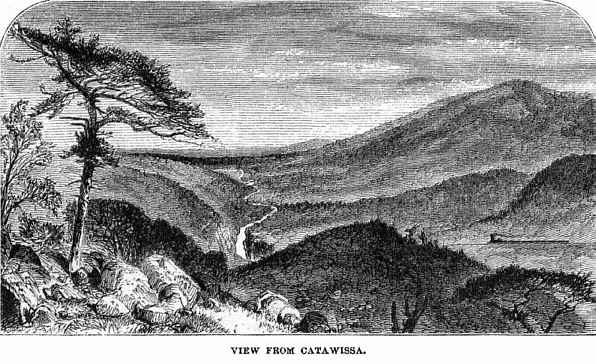 Further on the road reaches Milton,
Pennsylvania. This is a very thriving town of small extent at
the junction of the Sunbury and Erie Railway Company. The cars
of the Northern Central Road, from Baltimore and Harrisburg, also
are joined to the train, and proceed on to Williamsport, the terminus
of the line of the Catawissa Railroad. Further on the road reaches Milton,
Pennsylvania. This is a very thriving town of small extent at
the junction of the Sunbury and Erie Railway Company. The cars
of the Northern Central Road, from Baltimore and Harrisburg, also
are joined to the train, and proceed on to Williamsport, the terminus
of the line of the Catawissa Railroad.
Williamsport possesses a new and substantially-built court-house,
several hotels, a number of churches of various denominations,
and a seminary of learning which has a wide, reputation. Its location
is very healthy—upon the right bank of the Susquehanna River.
It has regularly laid-out streets, which are lighted with gas,
and the houses supplied with the purest water, conveyed from a
stream upon the mountain back of the borough. The railroad running
to Elmira here terminates, and from the several railroads the
influx of strangers at times is quite large. In the summer season
there could be no more delightful or healthful resort selected
than this very town of Williamsport. The facilities of obtaining
the dailies of the cities, with ease of egress or access, make
it peculiarly desirable; while the mountain streams, on the line
of the Catawissa Railroad, and also upon the Elmira Road, near
to the town, afford the most satisfactory gratification to the
followers of Isaak Walton.
 The vast lumbering interests
centering at this point afford: employment to large numbers of
men in the various capacities of sawyers, engineers, canal boatmen,
raftsmen, etc. The mills themselves are extensive affairs in their
line, and will well repay a visit. The large number of logs—saw-logs—necessary
to carry on the business, on the scale upon which it is conducted
in this immediate vicinity, renders a systematic protection of
the various interests a matter of necessity. The vast lumbering interests
centering at this point afford: employment to large numbers of
men in the various capacities of sawyers, engineers, canal boatmen,
raftsmen, etc. The mills themselves are extensive affairs in their
line, and will well repay a visit. The large number of logs—saw-logs—necessary
to carry on the business, on the scale upon which it is conducted
in this immediate vicinity, renders a systematic protection of
the various interests a matter of necessity.
The manner of identifying the logs of the several parties engaged
in sawing lumber is simple. The name, or private mark, of the
parties owning the logs is branded by a heavy blow from an iron
marker upon the logs at the point where they are first thrown
into the river—away up in the wild woods of the interior.
There are organizations, entitled "Boom Companies,"
who have the means provided at the several sawing points along
the river in the way of long booms, or logs, chained together
at their ends, and thus strung across the river at intervals to
interrupt the passage of the logs. The logs owned at any given
point being secured and fastened, either in the milldam or in
a raft to the shore, the balance are let loose to float down to
the next boom company, and so each and every of the owners gets
his own.
The sawing of lumber into various shapes or sizes is a very
interesting process to the novice, and many hours may be well
employed in studying the various operations of the improved machinery
at Williamsport introduced into this branch of mechanics.
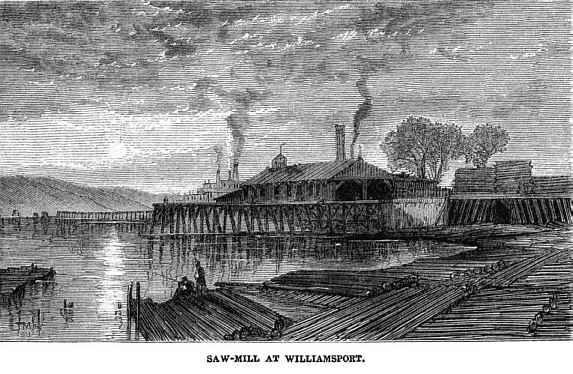 The lumber, when sawed, is forwarded
by railroad to New York, Philadelphia, and the various stations
along the line of the several roads leading to the cities. Also,
by means of canal transportation, large quantities go forward
during the season of navigation. The capital invested in the lumber
milling business is very heavy, and heretofore the results have
been in a great degree satisfactory to the parties concerned. The lumber, when sawed, is forwarded
by railroad to New York, Philadelphia, and the various stations
along the line of the several roads leading to the cities. Also,
by means of canal transportation, large quantities go forward
during the season of navigation. The capital invested in the lumber
milling business is very heavy, and heretofore the results have
been in a great degree satisfactory to the parties concerned.
Thus the coal-mining at the lower portion of the Catawissa
Road, and the lumber milling at the upper portion of it, afford
a world of pleasure and information when coupled with the very
grand views in nature with which the route abounds. The various
approaches to the Catawissa Railroad are in themselves very interesting
and pleasant rides; and leaving New York, or Philadelphia, or
Baltimore, the mountain scenery is reached in less than seven
hours from either point—rendering it quite possible to view
the whole in one day, and return the next. The routes from New
York are by the New Jersey Central Railroad to Easton, Pennsylvania,
thence by the Lehigh Valley and Quaquake Valley railroads to Quaquake
Junction; or by the same to Easton, by the East Pennsylvania Railroad
to Reading, Pennsylvania, thence to Port Clinton. Or by the New
York and Erie Railroad to Elmira, Chemung County, New York, thence
via Williamsport Railroad to Williamsport. The routes from Philadelphia
are by way of the Philadelphia and Reading Railroad to Port Clinton
direct.
Stories Page
| Contents Page
|







